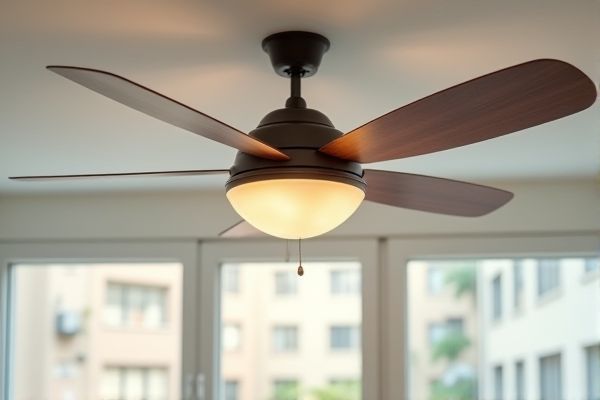
Choosing between a ceiling fan and an exhaust fan depends on your ventilation needs and room conditions, as a ceiling fan circulates air within a space to create a cooling effect, while an exhaust fan removes stale air, odors, and humidity from the room. To understand which option best suits your comfort and air quality requirements, explore the detailed comparison in the rest of this article.
Table of Comparison
| Feature | Ceiling Fan | Exhaust Fan |
|---|---|---|
| Primary Function | Circulates air within a room | Removes stale air and odor from a space |
| Usage | Cooling and air circulation | Ventilation and air extraction |
| Installation Location | Ceiling inside rooms | Walls or windows, usually kitchens and bathrooms |
| Airflow Direction | Horizontal circulation | Outward exhaust |
| Energy Consumption | Lower to moderate | Moderate to high |
| Noise Level | Generally low | Often higher due to motor and exhaust |
| Effect on Room Temperature | Perceived cooling via air movement | No direct cooling effect, only removes air |
| Maintenance | Regular dusting of blades | Frequent cleaning to avoid clogging |
Introduction to Ceiling Fans and Exhaust Fans
Ceiling fans circulate air within a room, enhancing comfort by creating a breeze that helps regulate temperature and reduce humidity. Exhaust fans, on the other hand, are designed to expel stale air, moisture, and odors from enclosed spaces like kitchens and bathrooms, improving indoor air quality. Understanding the distinct functions of ceiling fans and exhaust fans can help you choose the best solution for ventilation and cooling needs.
Key Differences Between Ceiling Fans and Exhaust Fans
Ceiling fans circulate air within a room to enhance airflow and create a cooling effect, while exhaust fans remove stale air, moisture, and odors from an enclosed space to improve ventilation. Ceiling fans are typically mounted on the ceiling and designed to direct air downwards, whereas exhaust fans are installed on walls or windows to expel air outside. The primary function of ceiling fans is air circulation for comfort, whereas exhaust fans focus on air extraction for improved indoor air quality.
How Ceiling Fans Work
Ceiling fans operate by rotating blades that create a breeze, enhancing air circulation and cooling through wind-chill effects. These fans use an electric motor connected to the blades, which spins to push air downward and distribute it evenly across a room. Unlike exhaust fans that remove stale air, ceiling fans improve comfort by continuously moving air within indoor spaces.
How Exhaust Fans Function
Exhaust fans operate by drawing stale air, moisture, and odors out of a room through a vent connected to the exterior, promoting ventilation. Powered by an electric motor, the fan blades create negative pressure that pushes the indoor air outside, preventing the buildup of humidity and pollutants. Commonly used in kitchens and bathrooms, exhaust fans improve indoor air quality and reduce mold growth by expelling airborne contaminants efficiently.
Energy Efficiency Comparison
Ceiling fans generally consume between 15 to 90 watts depending on size and speed settings, making them highly energy-efficient for circulating air and enhancing comfort. Exhaust fans, designed to remove stale air and moisture, typically use 50 to 100 watts but operate intermittently, which can result in higher overall energy use if run continuously. Your choice should consider that ceiling fans primarily promote air movement, reducing reliance on air conditioning and lowering energy bills, whereas exhaust fans improve air quality but may increase energy consumption over time.
Best Use Cases for Ceiling Fans
Ceiling fans are best used in indoor spaces like living rooms, bedrooms, and offices to provide consistent air circulation and enhance cooling efficiency. They optimize comfort by evenly distributing air, reducing reliance on air conditioning and lowering energy costs. Ideal for areas where people spend extended periods, ceiling fans maintain a steady breeze without removing humidity or odors.
Ideal Applications for Exhaust Fans
Exhaust fans are ideal for removing moisture, odors, and airborne pollutants in spaces such as kitchens, bathrooms, and laundry rooms, where ventilation is critical to maintaining air quality and preventing mold growth. They efficiently expel stale or humid air to the outside, reducing condensation and improving indoor comfort. Unlike ceiling fans that circulate air within a room, exhaust fans actively exchange indoor air with fresh outdoor air, making them essential for controlling humidity and ventilation in confined or high-moisture environments.
Pros and Cons of Ceiling Fans
Ceiling fans provide energy-efficient air circulation and cooling, reducing reliance on air conditioning and lowering electricity bills. They offer adjustable speed settings and can be used year-round to improve comfort in living spaces, but their effectiveness depends on proper installation and ceiling height. However, ceiling fans do not remove humidity or stale air, which limits their use in ventilation compared to exhaust fans designed for moisture and odor extraction.
Advantages and Disadvantages of Exhaust Fans
Exhaust fans excel at removing odors, smoke, and excess moisture from your space, improving indoor air quality and preventing mold growth. However, they can increase energy costs as they expel conditioned air and may create drafts that reduce overall comfort. While effective in ventilation, exhaust fans require careful placement and regular maintenance to avoid noise issues and ensure optimal performance.
Choosing the Right Fan for Your Space
Ceiling fans are ideal for circulating air within larger rooms, providing consistent airflow and energy-efficient cooling, while exhaust fans excel at removing moisture, odors, and stale air from confined spaces like kitchens and bathrooms. Selecting the right fan depends on the primary need: use ceiling fans to enhance comfort by improving air circulation, and choose exhaust fans to maintain indoor air quality by ventilating and eliminating pollutants. Proper fan placement and size also influence effectiveness, with ceiling fans requiring adequate ceiling height and exhaust fans needing vent access to the outdoors.
 homyna.com
homyna.com